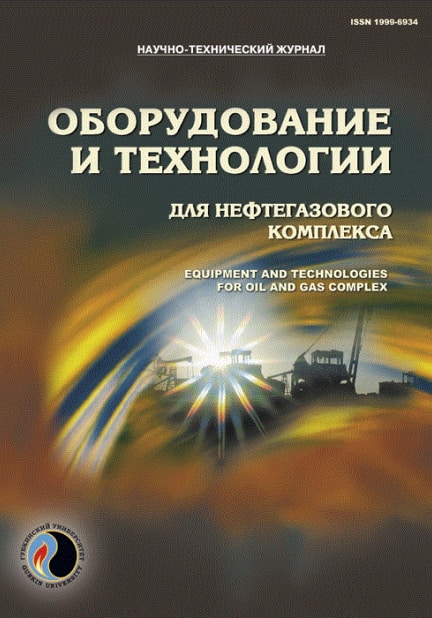Damage to pumping and compressor tubing in hydrogen sulfide-containing oil and gas environment
UDC: [622.32+622.24]:658.152
DOI: -
Authors:
MAMBETOV RINAT F. 1
1,
KOROLEV ANTON S. 1
1,
KHAFIZOV FANIL SH. 2
2,
KHAFIZOV ILDAR F. 2
2,
KUSHNARENKO VLADIMIR M. 3
3,
SOROKINA LYUDMILA V. 4
4
1 National University of Oil and Gas "Gubkin University", Orenburg, Russia
2 Ufa State Petroleum Technical University, Ufa, Russia
3 Orenburg State University, Orenburg, Russia
4 Samara State Technical University, Samara, Russia
Keywords: destruction, damage, hydrogen sulfide-containing oil and gas environments, hydrogen sulfide cracking, tubing
Annotation:
Investigation of damage to tubing operation is a relevant topic. Issues of technological safety of metal parts and structures, caused by hydrogen sulfide corrosion, as well as the quality of design, construction, and operation, demand attention. The importance of this matter is linked to the need to evaluate the impact of these factors on the reliability and safety of tubing operation [1–7]. Damage to the tubing was considered and a fragment of a damaged tubing pipe Ø73×5,51 mm and a fragment of a damaged tubing pipe Ø73×5,5 mm were examined. Based on the spectral analysis results of the chemical composition of the metal, metallographic studies of the metal and determination of hardness, the main causes of damage to tubing in hydrogen sulfide-containing oil and gas fields were determined. The cause of the tubing damage Ø73×5,51 mm is metal hydrogen sulfide cracking the under the influence of a hydrogen sulfide-containing oil and gas environment, which led in the area of stress concentrators – at the location of the key marks – to the initiation of microcracks in the tubing metal, which then turned into a macrocrack, causing through damage to the tubing. The cause of the tubing Ø73×5,5 mm damage is the marking imprint on the pipe, in the area of which, when the tubing was operated under conditions of exposure to a hydrogen sulfide-containing oil and gas environment, microcracks formed as a stress concentrator, which then merged into a macrocrack, which led to the destruction of the pipe.
Bibliography:
1. Razrushenie elementov konstruktsiy, kontaktiruyushchikh s korrozionnymi sredami / V.M. Kushnarenko, S.V. Pastukhov, Yu.A. Chirkov, E.V. Kushnarenko // Prochnost' i razrushenie materialov konstruktsiy: materialy 4-y Mezhdunar. nauch. konf., M., 15–17 fevr. 2005 g. – M.: RAE, 2005. – S. 82–84.
2. Mambetov R.F., Kushnarenko V.M., Ganin E.V. Razrusheniya detaley i konstruktsiy neftegazovogo oborudovaniya skvazhin v serovodorodsoderzhashchikh sredakh // Bezopasnost' truda v prom-sti. – 2018. – № 1. – S. 61–65. – DOI: 10.24000/0409-2961-2018-1-61-65
3. Analiz prichin otkazov oborudovaniya / V.P. Moiseev, R.F. Mambetov, V.M. Kushnarenko [i dr.] // Neftegazovoe delo. – 2017. – T. 15, № 1. – S. 181–185.
4. Povrezhdeniya truboprovodov ONGKM i opredelenie intensivnosti ikh otkazov / Yu.A. Chirkov, E.V. Kushnarenko, A.A. Bauer, D.N. Shchepinov // Territoriya Neftegaz. – 2008. – № 12. – S. 46–49.
5. Mambetov R.F. Serovodorodnoe rastreskivanie shtoka ventilya manometra // Oborudovanie i tekhnologii dlya neftegazovogo kompleksa. – 2019. – № 1(109). – S. 34–42. – DOI: 10.33285/1999-6934-2019-1(109)-34-42
6. Weight loss corrosion with H2S: using past operations for designing future facilities / M.R. Bonis, R.R. MacDonald, M.R. Girgis, K.R. Goerz. – Houston, Texas: NACE Int., 2006.
7. Smith S.N., Joosten M.W. Corrosion of Carbon Steel by H2S in CO2 Containing Oilfield Environments // NACE – Int. Corrosion Conf. Series. – Houston, Texas: NACE, 2006. – March.
8. RD 50-672-88. Metodicheskie ukazaniya. Raschety i ispytaniya na prochnost'. Klassifikatsiya vidov izlomov metallov. – Vved. 1989–07–01. – M.: Izd-vo standartov, 1989. – 21 s. – URL: http://docs.cntd.ru/document/1200059223
9. Fellouz Dzh. Fraktografiya i atlas fraktogramm: sprav. izd. – M.: Metallurgiya, 1982. – 489 s.
10. Corrosion Products of Mild Steel in Hydrogen Sulfide Environments / F.H. Meyer, O.L. Riggs, R.L. McGlasson, J. Sudbury // Corrosion. – 1958. – Vol. 14, No. 2. – P. 109–115. – DOI: 10.5006/0010-9312-14.4.62
11. GOST 9013-59. Metally. Metod izmereniya tverdosti po Rokvellu. – Vved. 1960–01–01. – M.: Izd-vo standartov, 2001. – 7 s. – URL: https://internet-law.ru/gosts/gost/18434
12. Dugstad A. Fundamental Aspects of CO2 Metal Loss Corrosion – Part 1: Mechanism // NACE – Int. Corrosion Conf. Series. – Houston, Texas: NACE, 2015.
13. NACE MR0175/ISO 15156. Petroleum and natural gas industries – Materials for Use in H2S–containing Environments in Oil and Gas Production. – NACE/ISO, 2015. – 164 p.
14. Rogers W.F., Rowe A. Corrosion effects of hydrogen sulphide and carbon dioxide in oil production // 4th World Petroleum Congress, Rome, Italy, June 6–15, 1955. – Rome, 1955. – P. 479–499.
15. Potak Ya.M. Khrupkie razrusheniya stali i stal'nykh detaley. – M.: Oborongiz, 1955. – 389 s.

